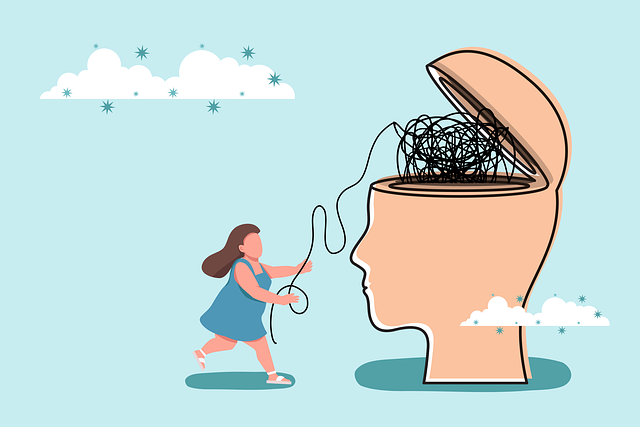Childhood trauma significantly impacts development and well-being, leading to mental health issues like anxiety, depression, and behavioral problems. Early intervention through specialized therapies like CBT and EMDR is crucial for processing traumatic memories and developing healthy coping strategies. Tailored therapy settings that promote safety, trust, and expression are essential. Evidence-based approaches, such as CBT and compassion cultivation, aid in managing negative thought patterns and emotions associated with trauma. Community outreach programs and collaboration between schools, healthcare providers, and community centers offer comprehensive support networks for at-risk individuals, fostering healing and resilience.
Trauma is a significant challenge affecting many children, with various types, including abuse, neglect, and acute events. Understanding its profound impact on their development is crucial. This article explores comprehensive support services for traumatized children. We delve into the role of therapy, emphasizing evidence-based approaches. Additionally, we discuss creating safe spaces, community resources, and collaboration to provide holistic trauma care, focusing on effective treatment strategies tailored for children’s unique needs.
- Understanding Childhood Trauma: Types and Impact
- The Role of Therapy in Supporting Traumatized Children
- Creating a Safe Space: Environment and Setting for Trauma Therapy
- Evidence-Based Approaches for Effective Treatment
- Community Resources and Collaboration for Comprehensive Support
Understanding Childhood Trauma: Types and Impact

Childhood trauma, encompassing a range of adverse experiences, can profoundly shape a child’s development and well-being. This includes events such as abuse (physical, emotional, or sexual), neglect, exposure to violence, or severe loss—all of which can leave lasting scars. Recognizing and understanding these traumatic experiences is paramount in providing effective support. The impact of childhood trauma is multifaceted; it may manifest as anxiety, depression, difficulty regulating emotions, behavioral problems, or even physical symptoms like chronic pain.
Early intervention through tailored therapy for children experiencing trauma is crucial. Therapies such as Cognitive Behavioral Therapy (CBT) and Eye Movement Desensitization and Reprocessing (EMDR) have proven beneficial in helping children process traumatic memories and develop healthy coping mechanisms. Moreover, promoting self-care routine development for better mental health can empower children to manage their emotions effectively. Community outreach program implementation can also play a vital role in identifying at-risk individuals and providing much-needed support networks.
The Role of Therapy in Supporting Traumatized Children

Trauma is a profound experience for any individual, but it can have an especially deep impact on children. When a child experiences trauma, therapy plays a vital role in their healing journey. Through specialized therapy sessions tailored to their age and developmental stage, traumatized children learn coping mechanisms and safe spaces to process their experiences.
Play therapy, cognitive behavioral therapy (CBT), and eye movement desensitization and reprocessing (EMDR) are examples of evidence-based approaches that help children understand and manage intense emotions associated with trauma. These therapeutic methods encourage expression through play, exploration of thought patterns, and the development of healthy coping strategies. By fostering a sense of safety and trust, therapy empowers children to develop resilience and build positive thinking skills, crucial for navigating the challenges that may arise from their traumatic experiences. Public awareness campaigns focused on normalizing conversations around trauma can further support these efforts by promoting understanding and reducing stigma, ultimately contributing to the development of effective trauma support services.
Creating a Safe Space: Environment and Setting for Trauma Therapy

Creating a safe space is paramount for effective therapy for children trauma. The environment and setting play a crucial role in fostering trust and encouraging vulnerability. This involves more than just physical safety; it encompasses emotional security and a non-judgmental atmosphere. A conducive space allows children to express their feelings freely, using Mind Over Matter principles to help them understand and manage their emotions. This is where empathy building strategies come into play, as therapists create a nurturing environment that respects each child’s unique experiences and perspectives.
The setting should be tailored to meet the individual needs of every child. For instance, a child who experienced trauma in a school setting may require a more familiar, comforting atmosphere within the therapy room. Using familiar toys, colors, or even music can help ground them and promote emotional regulation. By creating such a safe haven, therapists enable children to begin their healing journey, ensuring they feel heard, understood, and supported throughout the therapeutic process.
Evidence-Based Approaches for Effective Treatment

Trauma support services for children often centre around evidence-based approaches that have proven effective in treating complex trauma and enhancing resilience. One such approach is Cognitive Behavioural Therapy (CBT), which helps young individuals identify and change negative thought patterns resulting from traumatic experiences. By teaching them practical coping mechanisms, CBT boosts their confidence in managing distressing emotions and memories.
Complementary practices like Compassion Cultivation can significantly enhance the therapeutic process. These techniques foster empathy, self-acceptance, and compassion towards oneself and others, which are crucial for healing emotional wounds. Combined with effective communication strategies, these evidence-based methods create a safe space for children to express their experiences, fostering understanding and facilitating more meaningful interactions between clients and therapists.
Community Resources and Collaboration for Comprehensive Support

In providing comprehensive trauma support, especially for children, the power of community resources and collaboration cannot be overstated. Local communities often possess unique insights into their members’ needs and can offer tailored solutions. Collaboration between various organizations—including schools, healthcare providers, and community centers—can lead to a holistic approach in addressing trauma. This coordinated effort ensures that children receive not just therapy for children trauma but also access to empathy building strategies, emotional well-being promotion techniques, and compassion cultivation practices that cater to their specific cultural and social contexts.
Through such partnerships, support systems can be woven tightly around these vulnerable individuals. Schools, for instance, can incorporate trauma-informed teaching methods while community centers might host group sessions focused on resilience-building. Healthcare providers can offer specialized services while also referring families to local support groups. This multifaceted approach recognizes that trauma is a complex issue requiring diverse interventions. By harnessing the collective strength of the community, it becomes possible to foster healing and create lasting positive change for children affected by traumatic experiences.
Trauma support services are pivotal in fostering the healing process for children who have experienced adverse events. By addressing childhood trauma effectively, we can significantly improve their short-term and long-term well-being. Integrating various therapeutic approaches, safe environments, and community resources as outlined in this article equips professionals with essential tools to provide holistic care for traumatized children. Understanding the impact of different types of trauma and utilizing evidence-based treatments are key steps towards ensuring these young individuals receive the best possible support, enabling them to thrive despite their past experiences.












